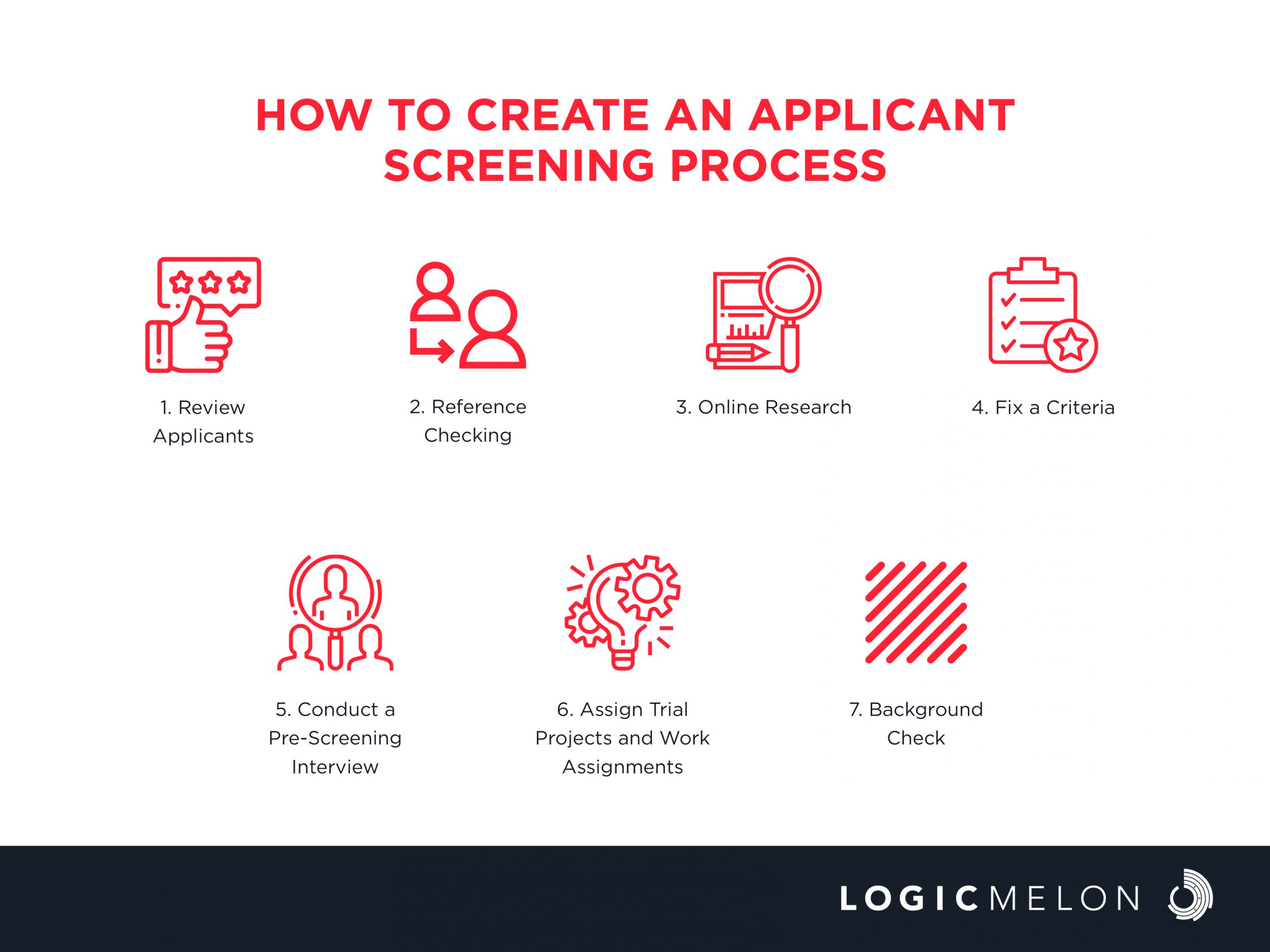How to Create an Applicant Screening Process
Screening applicants is part of the overall hiring process, which comes before the interview process, and after you have collected resumes through a job advertisement or recruitment event.
Applicant screening refers to determining if a candidate is qualified to continue through the hiring process based on their skills, experience, and expertise.
The Importance of Screening an Applicant
The applicant screening process is used by recruiters and hiring managers to obtain information from the applicant’s resume, and follow up with an initial interview over the phone or computer.
Screening applicants help you to eliminate those who do not meet the minimum requirements for the job, or who may not be a good fit for your company’s culture. This process helps to save money and time on the recruitment process by not conducting interviews for unqualified applicants.
Tools Used to Screen Applicants
The following tools are used in the applicant screening process:
Job Screening Questions
You can set up questions for applicants and, depending on their answers, they may be automatically disqualified if they do not meet the minimum job requirements.
Ranking Applicants
This can help you find out who you want to continue further in the process, and who is not a good fit for the job.
Cognitive and Behavioral Assessments
This assessment can help to further understand the applicants you have for the vacant position, and whether their behavioural decisions are suitable for the role or not.
Video Interviews
About 60% of job recruiters use video technology to interview candidates remotely. Set up specific interview questions for each job opening, and then all the candidates for that position can answer the set of questions through their smartphone or tablet on their time.
Skills Testing
Testing your applicant’s soft and hard skills to get a deeper understanding of who they are, and if they would be a good fit for the company or not.
How to Create an Applicant Screening Process

1. Review Applicants
Reviewing applicants is the first step to be considered by an organisation to assess the candidate’s profile to see if they meet the standards set by your organisation, and to check whether they would fit in your company’s culture or not.
While considering an applicant, check whether they meet the criteria set by your organisation. Using an Applicant Tracking System (ATS) helps to look for resumes that have the keyword and qualifications on the resumes.
2. Reference Checking
Reference checking is important to learn more about the candidate from previous employers, which includes questions about how they performed at their previous jobs, and how they handled feedback. This process helps to give insights about the candidate’s work ethic and strengths to get the best out of the candidate in your organisation.
3. Online Research
Research the potential applicants to learn more about them. Searching for a candidate on the internet can help to find out their interest, accomplishments, and hobbies. There is a possibility that you can find articles on the internet about the applicant receiving an award for an accomplishment in their previous workplace.
4. Fix a Criteria
Screen candidates who include items, such as skills like excellent communication or someone with a certain amount of experience in the field. Identify nice-to-have skills before, so that it is easy to screen candidates who meet your desired criteria. This process helps to eliminate the candidate who is not qualified for the role that you’re offering.
Criteria are different for every organisation and change according to the size, culture, and vacant role for which the organisation wants a candidate.
5. Conduct a Pre-screening Interview
Have pre-screening interviews with applicants who meet the minimum and preferred qualifications. This process helps to gain more information about the candidate that helps you to decide whether you wish to continue with the hiring process. Beware of the candidates who provide inconsistent details or information in interviews that do not match their resumes.
6. Assign Trial projects and Work Assignments
Checking whether a candidate can perform key responsibilities that they need in the organisation helps to see if they need skills to succeed with your company, or whether they can they meet the set deadline.
Consider giving a strong applicant profile a paid trial project to see how they perform in the organisation and a personality test to check what their behavior traits are.
7. Background Check
Depending on the job, run a background check on the applicant. This could help you to know how well the applicant deals with clients when they are at the organisation. Checking criminal background for a position where they would interact with children. The other considerations include running a drug test or checking their credit score.
Frequently Asked Questions
1. Is phone screening an interview?
A phone screening interview is a phone call where the recruiter can determine if a candidate is qualified to move on with the interview stage. Recruiters often use a phone screening questions template to help guide their questions.
2. Why applicant screening is used in the recruitment process?
Screening applicants gives insights into the candidate’s communication skills, and ability to answer interview questions. This is especially important information for a job that requires certain skill sets.
3. Does every applicant get a screening interview?
No, screening applicants do not always need to be conducted for screening interviews. If the company does not receive enough applicants then you can jump ahead to the formal interview process.
4. What causes a reflag on a background check?
If there is a criminal record that includes a history of violent crimes, sexual offenses, robberies, or serious drug offenses, it can make it difficult to pass a background check. However, it is still possible to get a job even if you have a criminal history.
Closing Thoughts
The applicant screening process involves reviewing job applications, involves scanning through the resumes, and finding the applicant who matches the job description. While screening, you should concentrate on hiring a candidate who meets the desired criteria, and who passes the background check to move further along the hiring process.
Creating an applicant screening process consists of reviewing the applications, reference checking, online research, fixing criteria, conducting the pre-screening interview process, assigning trial work assignments, and checking their background.
LogicMelon
Award-winning recruitment software that will find, attract, hire and analyse the way you want to work. At LogicMelon, we have experienced software recruitment marketing specialists to help you build effective recruitment solutions supported by the best customer service you’ll find anywhere!
Email: [email protected] or call LogicMelon (UK) +44 (0) 203 553 3667 (USA) +1 860 269 3089
Recruitment Data Visualisation: Everything You Must Know
As a recruiter, you go through a lot of information daily. Recruitment data visualisation simplifies the complex data, making it easier to understand and act upon.
The Role of Soft Skills in Leadership Recruitment
In leadership development, soft skills are essential for identifying individuals who can not only manage but also inspire and guide teams to success.
ATS and CRM in Talent Acquisition
By utilising the strengths of ATS and CRM, organisations can create a comprehensive talent acquisition strategy that combines relationship building with an efficient hiring process.


